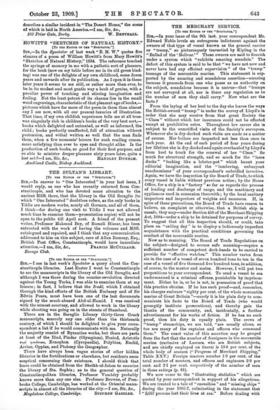[To THE EDITOR OF THE "SPECTATOR."] SIR, — I see in last
week's Spectator a query about the Con- stantinople libraries. Last Easter I went to Constantinople to see the manuscripts in the library of the Old Seraglio, and although I was there during the counter-revolution directed against the Young Turks, I was able to examine them at my leisure ; in fact, I believe that the Iradi, which I obtained through the kind efforts of the British Embassy and of Sir Edwin Pears, must have been one of the last documents signed by the much-abused Abd-ul-Hamid. I was received with the utmost courtesy, and allowed to work in the library while shooting was going on in the streets of Stamboul.
There are in the Seraglio Library thirty-three Greek
manuscripts, scarcely any one older than the thirteenth century, of which I should be delighted to give your corre- spondent a list if he would communicate with me. Naturally the majority consist of Byzantine works, but there are parts at least of the Iliad, Pindar (Olympians), Hesiod, Aristotle rEpi yevicreces, Xenophon (Cyropaedia), Polybius, Euclid, Arrian, Oppian, and Ptolemy the Geographer.
There have always been vague stories of other hidden libraries in the fortifications or elsewhere, but residents seem sceptical concerning their existence. I should think that leave could be obtained from the Sheikh-ul-Islam to examine the library of Sta. Sophia; as to the general question of Constantinopolitan libraries, Professor Vambery probably knows more than any one else. Professor Browne, of Pem- broke College, Cambridge, has worked at the Oriental manu- scripts in almost all the libraries of the city.—I am, Sir, &c., Magdalene College, Cambridge. STEPHEN GASELEE.










































 Previous page
Previous page